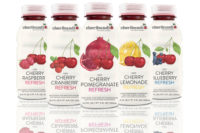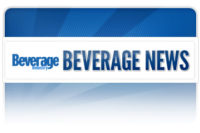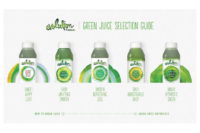Headlines about a select few professional and amateur athletes have put a negative connation on the term “juicing.” Although athletes aren’t without their share of “bad apples,” more and more consumers are giving the term a new, healthier definition.
“A trend that is positively impacting the juice category would be the whole concept of juicing and fasting,” says Virginia Lee, senior research analyst for Chicago-based Euromonitor International.
Lee notes that juice bars and juices that use high-pressure pasteurization methods are contributing to this trend, including super-premium brands like Starbucks Coffee Co.’s Evolution Fresh, which the Seattle-based company acquired in 2011.
According to Rockville, Md.-based Packaged Facts’ April 2013 “Fruit and Vegetable Juices” report, companies like Starbucks and Jamba Juice, Emeryville, Calif., have been making significant strides to expand their consumer packaged goods (CPG) presence.
“Direct competition from companies and brands that had their start in juice bars is another upcoming challenge for established marketers of packaged juices,” the report states.
However, not all analysts see this expansion as a threat to established CPG brands. Sarah Kahn, industry research analyst with IBISWorld, Santa Monica, Calif., thinks the retail segment could act as a complement to the CPG market. “The number of smoothies and smoothie places is definitely increasing,” she says. “In part, it supports this industry because it supports the health trend in general, and these new juicing bars have increased also, so I think they might be complementing each other to an extent.”
Chicago-based market research firm Mintel also noted the role that juicing could play in helping 100 percent juice offerings regain market share, according to its November 2013 report “Juice and Juice Drinks – US.”
“Future growth among 100 percent juices may come from a growing interest in juicing,” the report states. “The expansion of juice offerings at foodservice appears more as a driver of retail sales than a deterrent, as consumers look for an affordable means of mimicking the health qualities of fresh-squeezed offerings.”
According to Chicago-based Information Resources Inc. (IRI), sales of refrigerated juice and juice drink smoothies were approximately $766 million for the 52 weeks ending Nov. 3, 2013, in total U.S. supermarkets, drug stores, mass merchandisers, gas and convenience stores, military commissaries, and select club and dollar retail chains. Sales were up approximately 27 percent in that timeframe compared with the prior-year period.
Accounting for the majority of the market share in this segment are Purchase, N.Y.-based PepsiCo’s Naked Juice brand (63.4 percent); Bolthouse Farms (21.1 percent), a brand of Campbell Soup Co., Camden, N.J.; and Atlanta-based The Coca-Cola Co.’s Odwalla brand (11.8 percent), according to IRI data. Euromonitor’s Lee adds that the sum of these brands increased 23 percent in value sales in 2012.
These premium juices are some of the fastest-growing brands in the juice marketplace, she says. Consumers are seeking better-tasting, convenient and "extra healthy" products, and many of these fortified juices seem to contain more vitamins and antioxidants than typical juices, she explains.
Accounting for smaller but recognizable market shares is WhiteWave Foods Co., Broomfield, Colo., (2.4 percent) with its Silk Fruit and Protein brand topping the portfolio’s sales, and Sambazon Inc. (0.5 percent) with its same-named smoothie and protein lines leading the way. In the fourth quarter of 2013, the San Clemente, Calif.-based company released Sambazon Energy Peppermint Mocha. Available through December 2013, the limited-edition smoothie blended Fair Trade acai, chocolate soy milk, peppermint and shade-grown coffee.
The segment also is seeing entries from smaller companies as well. At Natural Products Expo East, New York-based Athena Brands Inc. released its Green Mustache organic fruit-and-vegetable juice smoothies. Each bottle provides one serving of fruit and one serving of vegetables without any added sugar in a 10-ounce bottle. The smoothies also contain ground chia seeds for calcium, omega-3 fatty acids, magnesium, fiber, and coconut water for potassium and electrolytes, the company says.
Not too sweet, please
Although health and wellness can have a positive effect on the category, it also has resulted in some adverse effects.
“Some 34 percent of respondents to Mintel’s custom consumer survey who do not drink or have reduced their consumption of products in the [juice] category say it’s because juice and juice drinks contain too much sugar,” the market research firm states in its report. It adds that the juice drinks segment has outpaced the growth of the 100 percent juice segment in recent years because of the increase in the number of reduced-calorie and reduced-sugar offerings. According to Mintel’s findings, 100 percent juice sales fell 10 percent from 2008 to 2013 to $9.6 million. In comparison, juice drink sales increased by 8 percent during that same timeframe to $5.8 million.
“While 100 percent juices [contain] naturally occurring sugar, I would say in general [sugar] is a taboo word among people interested in health,” Euromonitor’s Lee explains. “That’s also led to some children’s beverage companies coming out with juice drinks that, while they don’t contain added sugar, they pretty much are diluting 100 percent juice with added water.”
Others use alternate sweeteners to bring down the sugar content. For instance, last year, Dr Pepper Snapple Group, Plano, Texas, launched Hawaiian Punch Aloha Morning drinks, which contain 40 percent less sugar than competing juice drinks, according to the company. The beverages were developed as an alternate breakfast option for children. The products include a blend of sweeteners including high-fructose corn syrup and sucralose.
Honest Tea, the Bethesda, Md.-based independent operating subsidiary of The Coca-Cola Co., released Honest Splash juice drinks in early 2013. The 70-calorie beverages are sweetened with organic fruit juice and contain between 30 and 31 percent juice in each 12-ounce bottle, the company says.
In Packaged Facts’ report, the market research firm notes that healthy alternatives to sugar could serve as an opportunity for juice marketers.
“If there is a magic bullet for marketers of juices and juice drinks concerned about continuous growth, it would be to devise credible ways to reduce sugar content in their products in a healthy way,” it states. “Consumers are already tuned in to the need to be careful about the calories in the juices they drink.”
PepsiCo’s Tropicana Trop50 brand, for example, sweetens the majority of its line with only Rebaudioside A (Reb A), a zero-calorie steviol glycoside extracted from the stevia plant. Its Lemonade and Raspberry Lemonade varieties include Reb A as well as sucrose.
Citing data from Deerfield Beach, Fla.-based Simmons Market Research’s National Consumer Survey (NCS) division, Packaged Facts says the number of households drinking diet juices increased 40 percent between 2007 and 2012.
Keeping things in check
In its report, Mintel noted that U.S. retail sales of juice and juice drinks have declined 4 percent from 2008 to 2013 (12 percent when adjusted for inflation) to a total of $15.5 billion. Although the category has experienced some challenges, the market research firm predicts this decline will come to a stop.
“Mintel forecasts the losses to stop in the near future and the category to stagnate as the market expands with healthful calorie- and sugar-conscious options,” it states. “Future growth will depend on the category’s ability to present its products as convenient and affordable alternatives to competing beverage options.”
According to IRI data, the overall refrigerated juice and juice drinks category saw an increase of approximately 3 percent for a sales total of more than $6.6 billion in IRI-measured channels for the 52 weeks ending Nov. 3, 2013. In comparison, the shelf-stable bottled juice category experienced a slight decrease by 3.2 percent in sales to more than $6.8 billion. Aseptic juices were relatively flat for the time period, totaling $1.5 billion in sales. The category did, however, see strong growth from canned juices, which were up 17.2 percent to more than $1.1 billion in sales, and from juice and juice drink concentrates, which were up 63.6 percent for nearly $52 million in sales.
Not all juice categories fared as well, though. Frozen juices were down roughly 9 percent totaling more than $406 million in sales, based on IRI data.
Citing Simmons NCS data, Packaged Facts’ report states that frozen orange juice experienced a 14.7 percent decline in volume consumption between 2007 and 2012. But frozen variants were not the only ones that experienced a reduction. Although the data found that fruit juice and juice drink consumption volume increased 5.2 percent during that time period, non-frozen orange juice registered slight declines of 3.6 percent, Packaged Facts reported.
For refrigerated orange juice, the segment was relatively flat and charted more than $3.4 billion in sales for the 52 weeks ending Nov. 3, 2013, IRI reports.
IBISWorld’s Kahn notes that orange juice remains the most popular of the fruit and vegetable juice segments, but it has lately experienced some underperformance, which could be attributed to sugar content and citrus greening. Citrus greening is a bacterial disease that is harmless to humans but greatly reduces citrus production, destroys the economic value of the fruit, and can kill trees, according to the U.S. Department of Agriculture’s Animal and Plant Health Inspection Service (APHIS).
Among the sales leaders for orange juice, The Coca-Cola Co.’s Simply and Minute Maid brands and PepsiCo’s Tropicana brand together account for more than half of the market share. According to IRI data, The Coca-Cola Co. accounts for just more than 32 percent, and PepsiCo makes up 31 percent. Private label comes in third with 16.6 percent market share followed by Citrus World Inc., Lake Wales, Fla., with 12 percent market share.
At the National Association of Convenience Stores (NACS) Show in October 2013, Citrus World Inc. announced that its Florida’s Natural Growers Pride juices will be reformulated to remove high-fructose corn syrup. The reformulation is expected to take place this month.
IBISWorld’s Kahn also notes that apple juice is a popular segment of the juice category and accounts for a little more than 30 percent of the market. In the shelf-stable category, apple juice sales were relatively flat, accounting for more than $922 million in sales, according to IRI data. Within refrigerated juices, sales increases were modest at 1.5 percent to just shy of $62 million.
Capitalizing on the popularity of apple juice, Ft. Lauderdale, Fla.-based National Beverage Corp.’s Everfresh brand released last year Everfresh Varietals in five flavors: Fuji, Golden Delicious, Granny Smith, Honey Crisp and McIntosh.
Although some segments of the juice category have faced challenges, some of the smaller or less-established sub-categories have been a bright spot for the juice and juice drinks market.
“Coconut water has been a new trend, mostly due to the high electrolytes and the health benefits for the heart and regulating blood pressure,” IBISWorld’s Kahn says.
Euromonitor’s Lee notes that among the top coconut water brands, the market research firm found that value sales increased by 96 percent in 2012.
The segment also continues to get interest from larger companies. In late 2013, The Coca-Cola Co. acquired the outstanding ownership stake in Zico Beverages LLC, El Segundo, Calif. The move completes the transaction, which began in 2009 when Coca-Cola’s Venturing and Emerging Brands (VEB) business unit first invested in the company. In 2012, The Coca-Cola Co. purchased a majority stake in the brand, and in 2013, distribution for the brand joined Coca-Cola trucks throughout the United States and Canada.
“When we made our investment in Zico, we did so because we saw it as a burgeoning premium brand with the potential to be a significant leader in a high-growth category,” said Deryck van Rensburg, president and general manager of VEB at Coca-Cola North America, in a statement. “Over the past four years, we have watched the coconut water category see an impressive spike in revenue and household penetration and Zico solidify its position as one of the leading brands in this category. With our acquisition, we plan to innovate in all aspects of the consumer experience and increase both velocity and distribution to position Zico for even more growth. This announcement is the sign of a continued beginning for the brand with more resources, support and cachet to come.”
However, large brands and companies are not the only ones making a splash in the coconut water market. Bai Brands LLC, Princeton, N.J., introduced its summer seasonal Bai5 Molokai Coconut last year. The 5-calorie beverage contains electrolytes from the coconut water and is infused with antioxidant-rich coffee fruit, the company says.
Another segment that is gaining ground is vegetable juices. Citing Simmons NCS data, Packaged Facts reports that consumption of tomato and other vegetable juices increased 19.3 percent between 2007 and 2012.
According to IRI data, refrigerated vegetable juice and juice cocktails increased roughly 24 percent for more than $71 million in sales for the 52 weeks ending Nov. 3, 2013, in IRI-measured channels. However, the shelf-stable segment of tomato and vegetable juice and juice cocktails experienced some contraction with a 2.8 percent decline to more than $441 million in sales.
According to Mintel’s report, vegetable flavor varieties that feature lower sugar and calorie counts have expanded in popularity. The market research firm also notes that the introduction of tropical and exotic ingredients could help attract users interested in flavor variety as well as appeal to taste preferences found within the growing ethnic and Hispanic population in the United States.
Last year, Campbell Soup Co. introduced its V8 V-Fusion Refreshers, which contain a 20-25 percent blend of fruit and vegetable juices. Among the new releases was a Tangerine Passionfruit variety.
But vegetable juice varieties might see another flavor emerge on the scene. Sourcing Gawker and a “Well Blog” from The New York Times, Packaged Facts says that beet juice is gaining more attention.
Beat Juice Beverage Co., Phoenix, recently reformulated its same-named juice offering to feature an enhanced flavor and nutritional profile and be GMO-free. The juice is composed of a blend of pomegranate, Concord grape and beet juices as well as hibiscus and Mega Gold grape seed extracts.
Fruitful future
Going forward, analysts anticipate that the juice and juice drink category will fare well.
“It’s only going to increase in the foreseeable future because as health trends kick off and this desire for more natural fruits or natural foods and juices [continues], the juice industry is going to do better in the future,” IBISWorld’s Kahn says.
In its report, Mintel estimates the juice and juice drinks market value to be $15.5 billion in 2013 and forecasts it to reach $16 billion in 2018, at a 95 percent confidence level. This estimate falls between its best case ($17.5 billion) and worst case ($14.5 billion) scenarios.

















